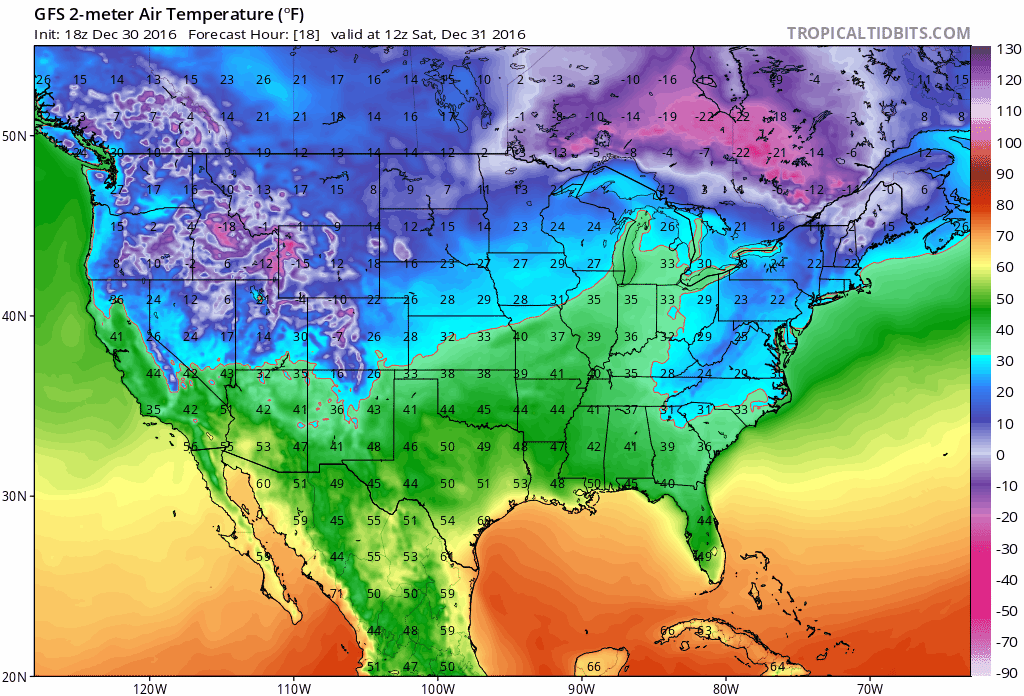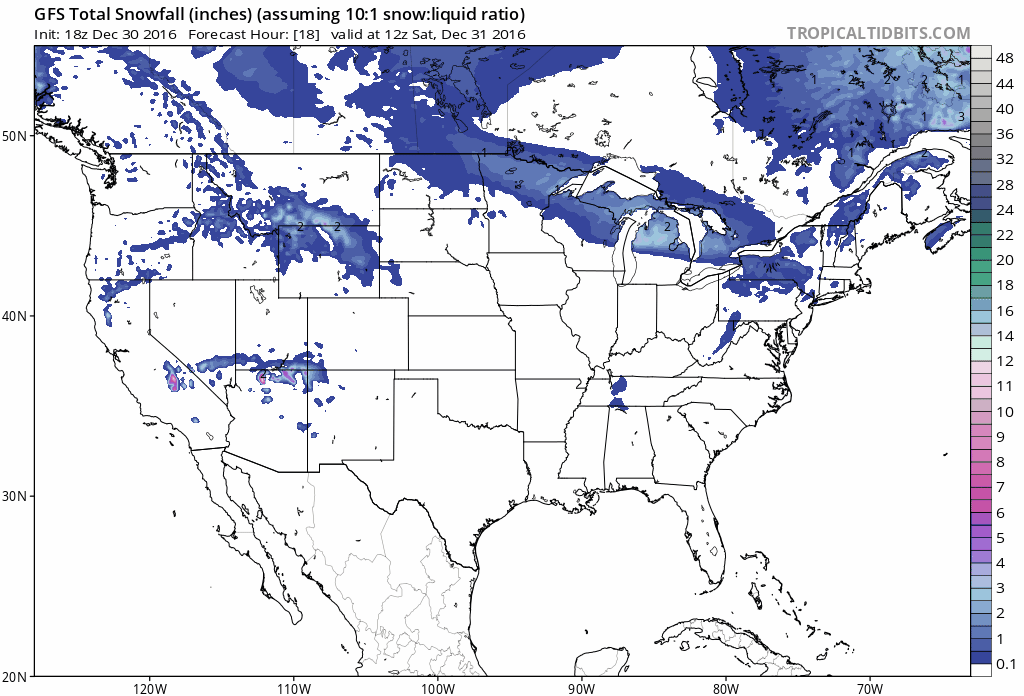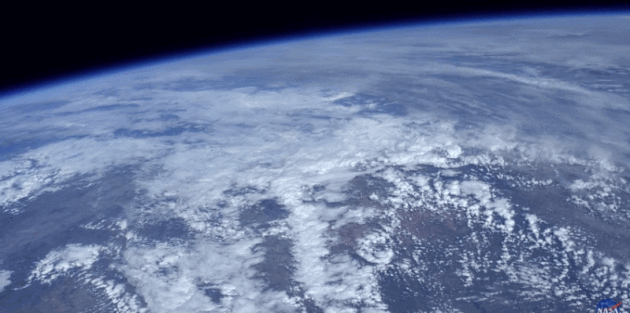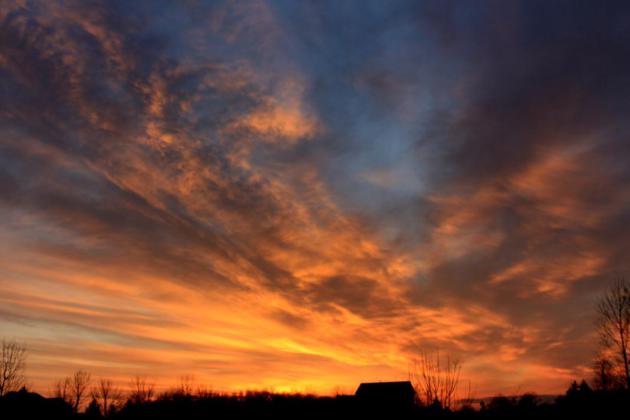29 F. maximum temperature observed in the Twin Cities on Friday.
24 F. average high on December 30.
25 F. high on December 30, 2015.
December 31, 1999:
It's a balmy end to the 2nd millennium over Minnesota, with
temperatures in the 30s over central and southern Minnesota near
midnight.
December 31, 1937: Damage is done by a flood at Grand Marais, while 18 inches of snow is dumped on Grand Portage.
December 31, 1913: New Ulm has its fortieth consecutive day without precipitation.
December 31, 1937: Damage is done by a flood at Grand Marais, while 18 inches of snow is dumped on Grand Portage.
December 31, 1913: New Ulm has its fortieth consecutive day without precipitation.

Farewell to 2016 - A Numbing Start to 2017
Live long enough and you'll see almost everything. 2016 was a fascinating, vaguely troubling year in the weather department. A 222 day growing season? Typical for northern Texas. There were boats in the water from late March thru early November.
For the first time on record two separate "mega-rain" events, defined as 6 inches or more of rain over 1,000 square miles. Dr. Mark Seeley says that, statewide, 2016 was the 3rd warmest and 2nd wettest year on record for Minnesota. Only 1977 was wetter.
Nationwide it was a year of historic floods from Louisiana & Texas to the Carolinas, Maryland and West Virginia. Historic warming of the arctic in recent months.
The grand experiment continues.
Flurries today give way to 30s New Year's Day and Monday, when a light mix may slush up a few roads, but I don't see a heavy accumulation right now.
Next week will be one of the coldest weeks of winter with lows dipping below zero by late week. Not record territory, but models show 1-2 weeks of numbing cold before milder, Pacific breezes kick in the third week of January. Embrace the burn!

Two Waves of Arctic Air Coming. Some of the coldest air of the winter drains out of Canada next week, pushing from west to east across the USA. The harshest, subzero air temperatures push across the Rockies and Plains into the Midwest and Great Lakes, but bitter air penetates to the Gulf Coast by late next week. 2-meter GFS temperature outlook: NOAA and Tropicaltidbits.com.
Missing El Nino Right About Now. Wind chills are forecast to dip into the -20F range by Thursday and Friday of next week, cold enough to get your attention.

10-Day Snowfall Potentiall. GFS guidance prints out over 10" snow for parts of northern Minnesota and the Arrowhead Monday night into Tuesday; a second streak of accumulating snow within 2 weeks from north Texas, Oklahoma and Arkansas into the Mid South, Carolinas and Mid Atlantic region. Big eastern cities may finally have some snow to play in (or whine about) within 2 weeks. Source: Tropicaltidbits.com.
* Minnesota reported 37 tornadoes in 2016, the first on May 25th in Pope County, and the last on September 9th in Beltrami County. The majority were short-lived and EF-0 rated ( winds 65-85 mph), and there were four storms rated EF-2 (winds 111-135 mph).
* Early planting for Minnesota farmers, followed by a generally favorable growing season with mostly excellent crop yields around the state.
* 2016 was the first year ever to bring two mega-rain events (1000 square miles covered by 6 inches or greater) to the state: one in east-central counties over July 11-12; and one in west-central counties August 10-11. Widespread flash flooding resulted.
* Latest ever autumn killing frost in the Twin Cities on November 18th
* Tied for warmest ever autumn season (September-November) on a statewide basis with 1963.
* Overall on a statewide basis 2016 delivered the 3rd warmest year in history to Minnesota (only 1987 and 2012 were warmer) and the 2nd wettest year (only 1977 was wetter)...
Fire Weather Outlook. This seems out-of-character for the last day of the year - critical fire danger from Oklahoma City and Tulsa to Wichita, according to NOAA.
Moderating Temperatures Third Week of January.
After mid-month the core of the coldest, subzero air rotates across New
England into eastern Canada; more of a moderate, Pacific flow returning
to most of the USA. In a little more than 2 weeks you may be able to
feel your extremities again.
Tracking Trends in U.S. Flood Risk. Eos connects the dots: "For 16 consecutive months in 2015 and 2016, Earth’s climate repeatedly broke global temperature records, in keeping with global warming trends observed over the past century and counting. During that period, there were major floods across the United States, including events in Missouri, Texas, Oklahoma, West Virginia, Maryland, and Louisiana. Warmer temperatures are associated with more frequent extreme precipitation events, and they increase the atmosphere’s water-holding capacity, suggesting that flooding across the globe will become more frequent in coming decades. Such an increase would have costly consequences for agriculture, water resources management, ecology, insurance, and transportation and navigation industries, as well as for civilians living in flood-affected areas. In light of this, hydrologists and atmospheric scientists are working to develop a more nuanced understanding of projected flooding changes to accurately communicate risks to the public..."
Photo credit: "Flooding near Houston, Texas, in April 2016." Credit: Tom Pistillo, USGS
Map credit: "A University of Iowa study has found that the risk of flooding is changing in the United States, and the changes vary regionally. The threat of moderate flooding is generally increasing in the northern U.S. (red areas) and decreasing in the southern U.S. (blue areas), while some regions remain mostly unchanged (gray areas). The findings come from comparing river heights at 2,042 locations with NASA satellite information showing the amount of water stored in the ground. The study was published in the journal “Geophysical Research Letters.” Image courtesy of the American Geophysical Union.
Photo credit: "After Jennifer and Ben Deneen’s Houston home was destroyed in a flood, they built this new two-story home in its place." Photo: Casey Woods for The Wall Street Journal.
Photo credit: "Jim Stefkovich has led the Birmingham office of the National Weather Service for more than 11 years. He will retire after 35 years with the weather service on Dec. 30." (Photo courtesy of Jim Stefkovich),

1) Global carbon emissions appear to have stopped increasing. A picture is beginning to emerge of a world where the increase in emissions of carbon dioxide seems to be flattening, despite countries’ continuing use of fossil fuels. In the United States, emissions are actually going down. Data from the Global Carbon Project suggests that global emissions have not changed for three years straight. Moreover, the cause has not been a global recession — growth has continued. What appears to be happening is a “decoupling” of economic growth from carbon emissions, thanks to more clean energy and other lower-emitting sources of energy like natural gas..."
Photo credit: "Deepwater Wind’s five-turbine project off the coast of Block Island, R.I., the nation’s first offshore wind farm, began operations this fall." (Michael Dwyer/AP)
Solar Looks to Outpace Natural Gas and Wind. Scientific American reports: "2016 is shaping up to be a milestone year for energy, and when the final accounting is done, one of the biggest winners is likely to be solar power. For the first time, more electricity-generating capacity from solar power plants is expected to have been built in the U.S. than from natural gas and wind, U.S. Department of Energy data show. Though the final tally won’t be in until March, enough new solar power plants were expected to be built in 2016 to total 9.5 gigawatts of solar power generating capacity, tripling the new solar capacity built in 2015. That’s enough to light up more than 1.8 million homes..."

Five Resolutions to Simplify Your Tech Life. Simplification sounds good - although I suspect it's impossible. Here's an excerpt from a worthy New York Times post: "...If
you are like most people, there are things you do with tech that could
use some tweaking. Strengthening your password security, for one, would
benefit you tremendously in an era when hacks are rampant. For another,
purging the e-junk you have accumulated over the years would help the
environment and your sanity. While you’re at it, start doing maintenance
on your electronics to make sure they work smoothly this year. Here are
my top recommendations for resolutions to abide by to make tech less
frustrating in the new year..."
For Better or Worse: New Books Forecast The Next Technologies. Here's an excerpt from a New York Times book review: "...But
wait. What happens when the 3.5 million Americans who drive trucks for a
living and the three million Americans who work on farms get booted
from their jobs by Uber-bots? What kind of social safety net might
soften the blow of that kind of sudden mass unemployment? What kind of
political movement might oppose the rise of a new, monopolistic
techno-agricultural power? What are the ecological implications of
putting food production in the hands of Silicon Valley tech companies?
These are the biggest, most important questions, and the ones on which
futurist thinking is most conspicuously absent.
Purify Yourself in the Waters of Lake Minnetonka?
Or the Minnesota River at Henderson. That's where the iconic water
scenes in the movie "Purple Rain" were apparently shot, based on
intelligence gleaned during our Paisley Park tour
yesterday. It was well worth the time and money. Prince was not only a
creative genius, but an accomplished businessman. It's rare to have both
skills tied up in one extraordinary person. We were lucky to have him
nearby - we miss you Prince Rogers Nelson. Your work continues to
inspire.

Check Out "Eagle-Cam". A couple of bald eagles sitting on a nest in Florida are whipping up a lot of online interest, as reported at NBC News: "...The
eagle cam, hosted by a real estate company, has been chronicling
Harriet's nesting seasons since 2012. Then, 16 million people tuned in
to watch Harriet and her former mate Ozzie raise two eaglets from their
birth to fledge, according to the company's website. This year, the
stream has amassed more than 57,670,000 views so far, according to the
site. "We have a PIP in one egg!! The hatching process has begun," read a
post on the eagle cam website Thursday afternoon..."
The Live Camera link is here, courtesy of Dick Pritchett Real Estate. The definition of good advertising!

TODAY: Windy, few flakes in the air. Winds: NW 10-15. High: 25
SATURDAY NIGHT: Partly cloudy and chilly. Low: 19
NEW YEAR'S DAY: Relatively mild start to 2017 with some sunshine. Dry. Winds: S 10-15. High: 36
MONDAY: Sloppy mix, mainly wet roads. Winds: E 10-15. Wake-up: 28. High: 35
TUESDAY: Colder wind, coating of flurries. Winds: NW 15-30+ Wake-up: 18. High: 20 (falling rapidly)
WEDNESDAY: Some sun, feels like -10F. Winds: W 10-15. Wake-up: 3. High: 10
THURSDAY: Partly sunny, slap on another layer. Winds: W 7-12. Wake-up: -4. High: 7
FRIDAY: Bright sun, windchill near -15F. Winds: NW 7-12. Wake-up: -9. High: 5
NEW YEAR'S DAY: Relatively mild start to 2017 with some sunshine. Dry. Winds: S 10-15. High: 36
MONDAY: Sloppy mix, mainly wet roads. Winds: E 10-15. Wake-up: 28. High: 35
TUESDAY: Colder wind, coating of flurries. Winds: NW 15-30+ Wake-up: 18. High: 20 (falling rapidly)
WEDNESDAY: Some sun, feels like -10F. Winds: W 10-15. Wake-up: 3. High: 10
THURSDAY: Partly sunny, slap on another layer. Winds: W 7-12. Wake-up: -4. High: 7
FRIDAY: Bright sun, windchill near -15F. Winds: NW 7-12. Wake-up: -9. High: 5
Climate Stories...
Photo credit: "Stephen Hadley said climate change will be one of the top national security issues for the next administration." | RODNEY LAMKEY JR. for POLITICO.
Europeans Ask: Where's The Snow? Ski Resorts Severely Impacted. The Daily Mail Online has a photo essay showing area ski resorts; a lack of snow has left an estimated 45,000 people unemployed. Here's an excerpt: "...Unusually high temperatures and a lack of snow is threatening the ski season as popular resorts in Europe have completely shut down. Some resorts in France have not seen so much as a snowflake in almost a month, leaving pistes completely bare. An estimated 45,000 workers have been left temporarily unemployed, lifts remain stationary and nobody is skiing on the slopes in the worst-hit areas in Massif Central, The Vosges and The Jura in France as well as Charmey in Switzerland..."
Photo credit: "A closed ski slope in Charmey, Switzerland on Boxing Day where the resort is closed due to the lack of snow." EPA.
7 Places That Will Change Because of Global Warming in Our Lifetimes. Here's an excerpt from Bustle: "As we're selfish creatures, however, it's often difficult to make clear how intensely bad this is without talking about how it affects us: our cities, our food, our holiday destinations, our ability to stay safe from conflict and natural disaster. The real nature of global warming is, unfortunately, global. And the impacts will be devastating: a study released this year noted that some places will likely see ocean rises of six meters or more as ice sheets collapse and melt, and by 2050 it's estimated that areas currently inhabited by 150 million people will be either flooding regularly or underwater. That's a lot of humans with nowhere to go and a lot of land that can't produce food. We're headed for a very bumpy ride; here are seven of the places that will be hit particularly hard by global warming in our lifetimes..."
File photo of Miami Beach: Daniel Chudosov, Flickr.
Which Cities Will Climate Change Flood First? Here's an except from Inverse: "...For some places, the reality of climate change and sea level rise is already here. Climate change was partly to blame for record flooding in Louisiana, Texas and Oklahoma in 2016, and as sea levels rise, we can expect to see a lot more waterlogged areas close to the coast. People around the world, including in the Pacific Ocean and coastal Louisiana, are seeing their land disappear under water and have been forced to relocate. Scientists are predicting a global sea level rise of one to four feet by 2100, while some areas may see even more water thanks to differences in plate tectonics. Other places are are starting to experience more severe flooding, and the future is looking considerably more damp. Here are a few major cities where sea level rise will force us to rewrite maps well before 2100..." (File photo of 2016 Lousiana flooding: Coast Guard).
Fish Seek Cooler Waters, Leaving Some Fishermen's Nets Empty. Here's a snippet from a New York Times article: "...Temperature
affects fish species differently. “Climate change is going to make it
hard on some of those species that are not particularly fond of warm or
warming waters,” said Mr. Brown, who is the president of the Rhode
Island Commercial Fishermen’s Association, a trade group. “But as the
impacts of climate change descend upon us, there are also species that
are going to be victorious, hugely victorious.” Yet the changes are
happening so fast that regulators will have to adapt quickly if they are
to have any hope of keeping up. Marine species, Dr. Manderson said, are
moving north at 10 times the rate of animals on land..."
Photo credit: "The
fishing industry faces antiquated regulations that have been overtaken
by climate change, as warming seas force a variety of fish to seek
cooler and deeper waters." Christopher Capozziello for The New York Times.
Photo credit: BillMoyers.com.

Exxon Favors a Carbon Tax.
The one things business hates more than anything is uncertainty and
shifting regulatory hurtles to navigate. Having a tax on carbon just
makes sense, according to the VP of Public and Government Affairs for
Exxon Mobil, in an Op-Ed at The New York Times: "...Exxon
Mobil supports a carbon tax as the best approach for policy makers
because it would ensure a uniform and predictable cost of carbon across
the economy, allow market forces to drive solutions and maximize
transparency to stakeholders. It would also reduce administrative
complexity, promote global participation and easily adjust to future
developments in climate science and policy consequences. The article
suggests that Exxon Mobil “has done little or nothing to help put carbon
taxes into effect.” Exxon Mobil executives have repeatedly made clear
the company’s position in briefings with members of Congress and in
media interviews and other communications..."
Graphic credit: "High Arctic Temp.s over the past 12 months. The black line is the average from 1981-2010. Red shows above normal temps. Note the incredible warmth all year that goes even to greater extremes in the last two months."
Photo credit: "The Ronald Reagan Ballistic Missile Defense Test Site at Kwajalein Atoll, Republic of the Marshall Islands, is among a growing number of U.S. military installations threatened by the effects of climate change, a recent report said." Courtesy of the U.S. Army.
Photo credit: "Former US Representative Bob Inglis was awarded the 2015 John F. Kennedy Profile in Courage Award for changing his position on climate change at big political cost." Credit: Brian Snyder/Reuters.
Climate Change Driving Birds to Migrate Early, Research Reveals. Not much of a stretch, considering the growing season is increasing with time. Here's an excerpt from The Guardian: "Migrating birds are responding to the effects of climate change by arriving at their breeding grounds earlier as global temperatures rise, research has found. The University of Edinburgh study, which looked at hundreds of species across five continents, found that birds are reaching their summer breeding grounds on average about one day earlier per degree of increasing global temperature. The main reason birds take flight is changing seasonal temperatures and food availability. The time they reach their summer breeding grounds is significant, because arriving at the wrong time, even by a few days, may cause them to miss out on vital resources such as food and nesting places. This in turn affects the timing of offspring hatching and their chances of survival..." (File photo: Wikipedia).
No comments:
Post a Comment